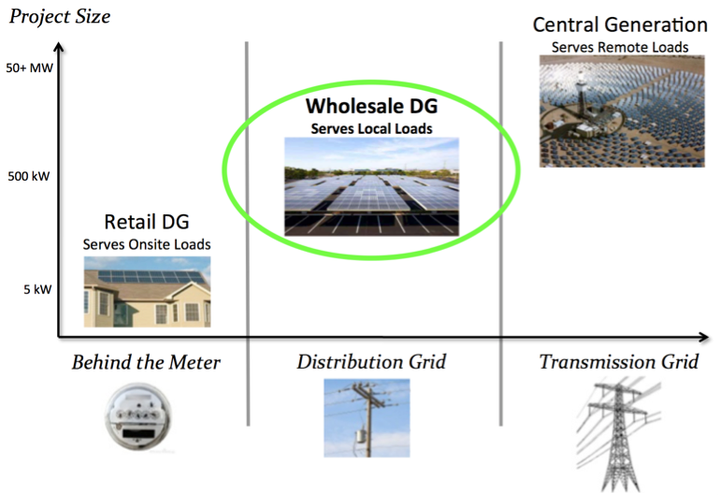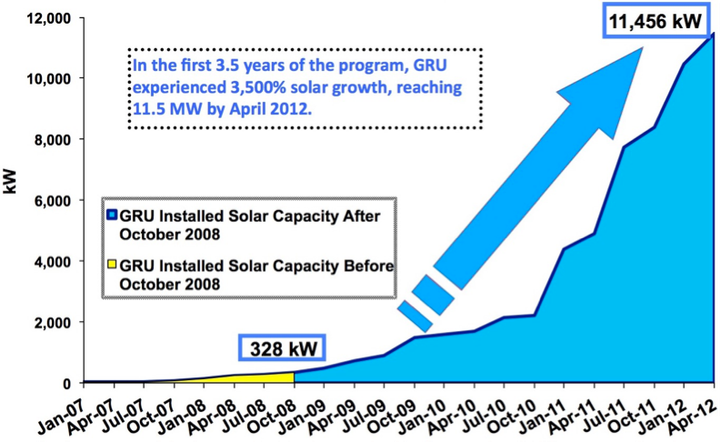The cost of local renewables continues to drop dramatically around the country. On the Hawaiian island of Kauai, the local electric cooperative just signed a deal for a multi-site solar+storage project that will deliver power to the grid — way beyond the sun setting — for 11 cents per kilowatt-hour (kWh). To put that in context, the average U.S. residential cost of electricity is 12.5 cents/kWh.
The Kauai project will provide electricity to the Kauai Island Utility Cooperative that is 30% cheaper than a similar solar+storage deal the cooperative made in 2015 — highlighting the aggressive pursuit of increased efficiency and reduced hardware costs by the renewable energy industry.
Policymakers and utilities also have a critical role to play in driving cost reductions for renewable energy projects. Policies that establish transparency, longevity, and certainty in the marketplace are essential to driving down the soft costs of project development. Feed-in tariffs (FITs) have proven very effective at streamlining the market, as evident in Germany, as well as across a variety of utility territories in the U.S. By replicating FIT policy successes, U.S. policymakers and utilities can further unleash the market for local renewables and make them the most cost-effective form of electricity in the country.
Lessons from Germany
U.S. policymakers need look no further than Germany to find a successful energy policy. Starting in 2000, Germany enacted a national FIT that propelled the country to become the world’s clean energy leader.
Germany experienced tremendous growth of local renewable energy because their FIT unleashed the wholesale distributed generation (wholesale DG) market segment. As shown below, wholesale DG refers to distributed generation systems that connect to the distribution grid and sell the electricity they produce to the local utility to serve local energy demand.

The three renewable energy market segments
The German FIT targeted the wholesale DG market by making it easy to build local renewable energy projects, connect them to the grid, and sell power to the local utility at a fixed rate using a standardized, long-term, and guaranteed contract. To date, Germany has integrated more than 38 gigawatts of solar PV into its grid — the most solar capacity anywhere in the world. During the 10-year period following the introduction of its national FIT, Germany ran laps around the United States, including deploying over ten times more solar capacity than California — far and away the leading U.S. state for clean energy. Incredibly, over 80% of Germany’s solar capacity is made up of projects 1 megawatt (MW) or smaller that are sited in the built environment close to where people live and use energy.

Germany vs. California in renewable energy deployment (2002-2012)
The German FIT was not only successful at driving deployment of renewable capacity, but the policy also created a highly efficient renewables market. Through fixed-rate, long-term contracts, the FIT created transparency, longevity, and certainty in the marketplace, which minimized risk and reduced financing costs. Furthermore, Germany simplified the interconnection process for wholesale DG projects — the interconnection process looks very similar to U.S. net metering interconnection policies.
Predictable, streamlined procurement and interconnection radically reduced the costs to build local renewable energy projects in Germany. Replicating Germany’s scale and efficiency in California would result in rooftop solar costing between 5-7 cents/kWh, due to California’s better solar resource and applicable tax treatments. The scale of the German market now enables deployment of commercial rooftop solar at $1.20 per watt — a price that is only achievable in California for massive, ground-based, transmission-dependent solar projects, where land is cheap and economies of scale enormous.

Replicating German scale and efficiencies would yield rooftop solar today at only between 5 and 7 cents/kWh to California ratepayers
Expanding the wholesale DG market in the United States
In the U.S., there is a lack of policy support for the wholesale DG market segment. Existing policies have focused primarily on driving deployment of large-scale renewables through Renewable Portfolio Standards, as well as small, customer-sited renewables — like residential rooftop solar — through net energy metering (NEM). The critically underserved wholesale DG market segment must be addressed as it offers a tremendous opportunity for cost-effective clean local energy.
NEM is indisputably effective for deploying retail DG projects across the country. Net metering policy works best for residential installations as it typically credits customers at their retail rate for any energy exported back to the grid. In fact, most solar systems in the U.S. are net metered, and NEM projects added over 2,100 MW of generation capacity in 2015.
Unfortunately, NEM does not effectively address the commercial-scale solar segment for a number of reasons. As Los Angeles Mayor Eric Garcetti explained, “Until L.A.’s FIT was launched, 75 percent of our city’s rooftop market was ineligible for solar because of insufficient load or because so many buildings are non-owner occupied or multi-tenant.” For properties in any of these situations, net metering is not an effective policy. A policy that supports the development of wholesale DG projects is necessary to bring the vast majority of these commercial properties into play. Fortunately, there are a growing number of success stories for addressing the wholesale DG market in the U.S.
Georgia Power shines with wholesale DG solar program
Georgia Power, a utility serving nearly 2.5 million customers deep in coal country, has emerged as a leading solar utility with roughly 900 MW of solar-generated electricity on its grid. The vast majority of this capacity came online through Georgia Power’s highly successful Advanced Solar Initiative, which was launched in 2012 and had a specific focus on expanding the wholesale DG market.
“Georgia Power has aggressive goals for utilizing solar power, including lots of local solar, without raising customer rates,” said John Kraft, a Georgia Power Spokesperson.
The utility has certainly been successful in achieving these goals. Georgia Power began the Advanced Solar Initiative by bringing 210 MW of solar online across the residential, commercial and industrial, and utility-scale segments. In 2013, Georgia Power, to the delight of state regulators, increased the Advanced Solar Initiative to 735 MW. Of this total capacity, 190 MW were carved out for wholesale DG projects, and all of this capacity has been built.
“The Clean Coalition's CLEAN Program Guide and other resources definitely facilitated the design and implementation of our programs, including the standard offer program we developed for commercial-scale solar projects," said Kraft.
Previous FIT programs in the U.S.
Georgia Power’s program was highly successful and received well-deserved attention. However, it was not the first utility program designed to enable growth of wholesale DG programs.
In 2009, the Sacramento Municipal Utility District introduced a FIT that brought 100 MW of local solar online at no additional cost to its customers. Gainesville Regional Utilities implemented a FIT in 2009 that drove more than a 3,500% percent growth in local solar capacity during the program’s first three years and created hundreds of local jobs. And other successful wholesale DG programs have been in place from Hawaii to Colorado to Vermont.

Gainesville Regional Utilities (GRU) solar capacity boomed after implementing its FIT
More FITs on the way
The use of FITs to drive growth of the wholesale DG market continues to gain steam across the country. The Hawaii Electric Company (HECO) recently announced plans to meet Hawaii’s 100% renewable target five years ahead of schedule. Part of HECO’s plan is to grow the wholesale DG market by purchasing power from 31 MW of renewables through an FIT. In California, Community Choice Aggregation (CCA) programs have fully embraced wholesale DG. Marin Clean Energy and Sonoma Clean Power both have successful FITs, and the newly formed San Francisco CCA — known as CleanPowerSF — is in the process of rolling out its own.
Expansion of existing programs is underway too. Fort Collins Utilities in Colorado just announced plans to for the next phase of its FIT, known as the Solar Power Purchase Program. And finally, Los Angeles Department of Water and Power, the nation’s largest public utility, is working on increasing its CLEAN L.A. Solar Program from 150 MW to 450 MW.
Although the U.S. will likely never have a federal level program like Germany did, state policies and utility programs supporting wholesale DG have proven highly successful. Building upon this success is critical to accelerating the deployment of cost-effective clean local energy across the country.
